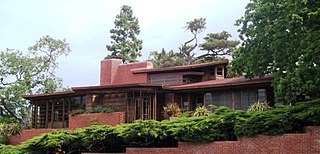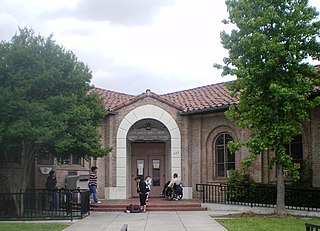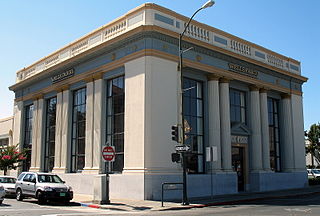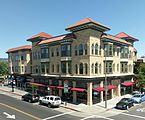
The Hanna–Honeycomb House, also known as simply the Hanna House, located on the Stanford University campus in Stanford, California, United States, was Frank Lloyd Wright's first work in the Bay Area and his first work with non-rectangular structures. The house was chosen by the American Institute of Architects as one of seventeen buildings by the architect to be retained as an example of his contribution to American culture. It was recognized as a National Historic Landmark on June 29, 1989.

Barstow Harvey House, also known as Harvey House Railroad Depot and Barstow station, is a historic building in Barstow, California. Originally built in 1911 as Casa del Desierto, a Harvey House hotel and Santa Fe Railroad depot, it currently serves as an Amtrak station and government building housing city offices, the Barstow Chamber of Commerce and Visitor Center, and two museums.

Pasadena City Hall, completed in 1927, serves as the central location for city government in the City of Pasadena, California and it is a significant architectural example of the City Beautiful movement of the 1920s.

Charmont Apartments is an historic apartment building in Santa Monica, California which was built in 1928. Designed by architect Max Maltzman with elements of both the Mission Revival-Spanish Colonial Revival style and the Art Deco style, the Charmont was a luxurious high-rise when it was built. The blending of Spanish Colonial Revival and Art Deco elements was popular style in the 1920s and is sometimes known as "Med-Deco." The main entrance is located in a walled courtyard that features a two-tiered fountain with an intricate Moorish-patterned backsplash in polychrome tile. The building was damaged in the 1994 Northridge earthquake and subsequently rehabilitated and listed on the National Register of Historic Places.

Robert Louis Stevenson Branch Library is a branch library of the Los Angeles Public Library located in the Boyle Heights section of Los Angeles, California. It was built in 1927 based on a Spanish Colonial Revival design by architect George L. Lindsay.

Northside Presbyterian Church is a historic Presbyterian church at 923 Mississippi Avenue in Chattanooga, Tennessee, affiliated with the Presbyterian Church USA.

The Hotel Virginia was built in 1925. It was listed on the National Register of Historic Places in 2000. It is also designated by the city of Santa Barbara as a local historical landmark. The building is located on the southern side of West Haley Street, 17 W. Haley Street, in the southeastern part of the historical center of Santa Barbara, California.
William H. Corlett, also known as W. H. Corlett, was an American architect and contractor active in Napa County, California and the surrounding area.

First Presbyterian Church is a historic church at 1333 3rd Street in Napa, California.

First Baptist Church of Ventura is a historic church at 101 S. Laurel Street in Ventura, California. It was built in 1926 and renovated extensively into the Mayan Revival style in 1932. Declared a landmark by the City of Ventura In 1975, the building was added to the National Register of Historic Places in 2009. Since 1952, it has been home to the Ventura Center for Spiritual Living.

The Goodman Library is a historic library located at 1219 1st St. in Napa, California. Built in 1901, the library was paid for by George E. Goodman and built on land donated by Goodman. Architect Luther M. Turton designed the building in the Richardson Romanesque style, which can be seen in its use of rusticated stone, round arch windows, and massive scale. The design represented a shift in Napa architecture, which was mainly Victorian prior to the library's construction.

The Sam Kee Laundry Building, also known as the Pfeiffer Building, is a historic building located at 1245 Main St. in Napa, California. Built in 1875, the building is the oldest stone building and commercial building in Napa. The building has a generally simple design topped by a decorative Italianate cornice. As of 1880, the building was part of a brewery, which may have been the first brewery in Napa; it has since housed a boarding house, a saloon, and a laundry. The building currently houses the Vintner's Collective, a wine tasting bar.

The Anchorage Hotel is a hotel located at 330 E Street in Anchorage, Alaska, United States. The original Anchorage Hotel building was built in 1916; the current hotel building, which was constructed as an annex to the hotel, opened in 1936. C.B. Wark built the first hotel building; while the building was originally a wood frame structure, Frank Reed upgraded the building to a luxury hotel in 1917. The hotel outgrew its original building due to Anchorage's growth in the 1930s, so the Anchorage Hotel Annex was built in 1936 to house additional guests. The annex, designed by E. Ellsworth Sedille, had a Gothic design and was one of the tallest buildings in Anchorage at the time. Guests at the hotel included Warren Harding, Harold L. Ickes, Walt Disney, Wiley Post, and Will Rogers; the latter two stayed at the hotel only two days prior to their deaths in a plane crash. In addition, artist Sidney Laurence lived in the hotel for parts of the 1920s and 1930s; Laurence once exchanged a painting of Mount McKinley for a year's rent at the hotel.

The Hotel Rosslyn Annex is a historic building in Los Angeles, California built in 1923 at the corner of 5th and Main streets. The structure was designed by the firm Parkinson & Parkinson in the Beaux Arts style and listed on the National Register of Historic Places in 2013.

The 2014 South Napa earthquake occurred in the North San Francisco Bay Area on August 24 at . At 6.0 on the moment magnitude scale and with a maximum Mercalli intensity of VIII (Severe), the event was the largest in the San Francisco Bay Area since the 1989 Loma Prieta earthquake. The epicenter of the earthquake was located to the south of Napa and to the northwest of American Canyon on the West Napa Fault.

The U.S. Post Office, also known as the Napa Franklin Station, served the 94559 zip code area of Napa, California. The post office was built in 1933 with funding from the Public Works Administration. Architect William H. Corlett designed the Art Deco building. The front facade of the building has three sections; the central section has six bays divided by piers with terra cotta capitals. A terra cotta cornice adorned with ram and cow heads tops the central section. The side sections, which contain the building's two entrances, feature panels with decorative eagle designs above the doorways and urn-shaped bronze light fixtures on either side. The post office's lobby features a painted bas-relief plastic ceiling, unusual in federally constructed post offices, and a terrazzo floor.

The Napa County Courthouse Plaza is a complex in Napa, California, which consists of the Napa County Courthouse and the Hall of Records. The two buildings occupy an entire city block, which includes open areas and landscaping to create the site's plaza setting. The High Victorian Italianate courthouse was built in 1878 to replace the original 1856 courthouse. The courthouse continues to serve as the seat of Napa County government. The 1916 Hall of Records is a federally sponsored records building designed by William H. Corlett. The Renaissance Revival building represents an early use of reinforced concrete as a building material; the material became popular nationwide in the 1920s.

The Bank of Napa, at 903 Main St. and 908 Brown St. in Napa, California was built in 1923. It was listed on the National Register of Historic Places in 1992.

The Hotel Fresno, in Fresno, California, was listed on the National Register of Historic Places in 2018.

The Cayetano Juárez Adobe, often called locally the Old Adobe, is the oldest building in Napa, California. Built in 1845 by early Californio settler Cayetano Juárez, the structure was originally a family house and was later converted to a restaurant and bar. After an ownership change in 2014, it underwent an extensive restoration which was completed in 2019. The building was added to the National Register of Historic Places in 2015. It is currently the home of a Mexican restaurant.

























